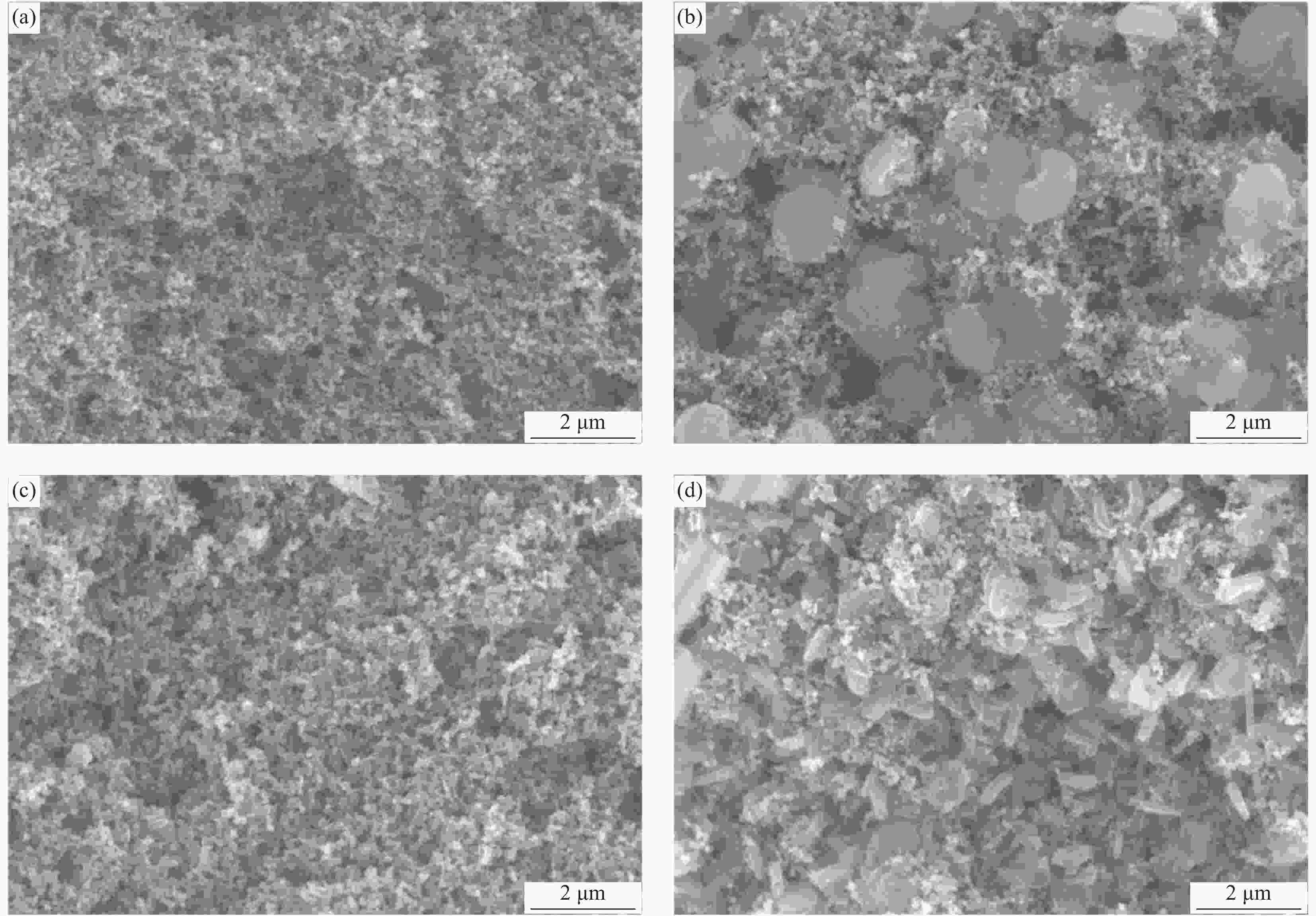| [1] |
YANG S, HE P, ZHOU H. Research progresses on materials and electrode design towards key challenges of Li-air batteries[J]. Energy Storage Materials,2018,13:29-48. doi: 10.1016/j.ensm.2017.12.020
|
| [2] |
WANG H F, WANG X X, LI M L, et al. Porous materials applied in nonaqueous Li-O2 batteries: Status and perspectives[J]. Advanced Materials,2020,32(44):2002559.
|
| [3] |
LUNTZ A C, MCCLOSKEY B D. Nonaqueous Li-air batteries: A status report[J]. Chemical Reviews,2014,114(23):11721-11750. doi: 10.1021/cr500054y
|
| [4] |
SONG L N, ZHANG W, WANG Y, et al. Tuning lithium-peroxide formation/decomposition routes with single-atom catalysts towards lithium-oxygen batteries[J]. Nature Communations,2020,11:2191. doi: 10.1038/s41467-020-15712-z
|
| [5] |
ZHANG Y, ZHANG X M, WANG J W, et al. Potential-dependent generation of O2– and LiO2 and their critical roles in O2 reduction to Li2O2 in aprotic Li-O2 batteries[J]. The Journal of Physical Chemistry C,2016,120(7):3690-3698. doi: 10.1021/acs.jpcc.5b12338
|
| [6] |
CHENG F, CHEN J. Metal-air batteries: From oxygen reduction electrochemistry to cathode catalysts[J]. Chemical Society Reviews,2012,41(6):2172-2192. doi: 10.1039/c1cs15228a
|
| [7] |
MCCLOSKEY B D, SPEIDEL A R, SCHEFFLER D C, et al. Twin problems of interfacial carbonate formation in nonaqueous Li-O2 batteries[J]. The Journal of Physical Chemistry Letters,2012,3(8):997-1001. doi: 10.1021/jz300243r
|
| [8] |
THOTIYL M M O, FREUNBERGER S A, PENG Z Q, et al. The carbon electrode in non-aqueous Li-O2 cells[J]. Journal of the American Chemical Society,2013,135(1):494-500. doi: 10.1021/ja310258x
|
| [9] |
ZHANG Z C, LU J, ASSARY R S, et al. Increased stability toward oxygen reduction products for lithium-air batteries with oligoether-functionalized silane electrolytes[J]. The Journal of Physical Chemistry C,2011,115(51):25535-25542. doi: 10.1021/jp2087412
|
| [10] |
MA L, YU T W, TZOGANAKIS E, et al. Fundamental understanding and material challenges in rechargeable nonaqueous Li-O2 batteries: Recent progress and perspective[J]. Advanced Energy Materials,2018,8(22):1800348. doi: 10.1002/aenm.201800348
|
| [11] |
LIU B, ZHANG J G, XU W. Advancing lithium metal batteries[J]. Joule,2018,2(1):1-13. doi: 10.1016/j.joule.2017.10.014
|
| [12] |
YANGH J, GUO C, NAVEED A, et al. Recent progress and perspective on lithium metal anode protection[J]. Energy Storage Materials,2018,14:199-221. doi: 10.1016/j.ensm.2018.03.001
|
| [13] |
LIU Q C, XU J J, YUAN S, et al. Artificial protection film on lithium metal anode toward long-cycle-life lithium-oxygen batteries[J]. Advanced Materials,2015,27(35):5241-5247. doi: 10.1002/adma.201501490
|
| [14] |
WANG H F, LI J F, SUN X X, et al. Stabilizing electrochemical Li-O2 batteries with a metal-based cathode of PdNi on Ni nonwoven fabric[J]. Nanoscale,2019,11(24):11513-11520. doi: 10.1039/C9NR02390A
|
| [15] |
XU J J, CHANG Z W, YIN Y B, et al. Nanoengineered ultralight and robust all-metal cathode for highcapacity, stable lithium-oxygen batteries[J]. ACS Central Science,2017,3(6):598-604. doi: 10.1021/acscentsci.7b00120
|
| [16] |
SONG L N, ZOU L C, WANG X X, et al. Realizing formation and decomposition of Li2O2 on its own surface with a highly dispersed catalyst for high round-trip efficiency Li-O2 batteries[J]. iScience,2019,14:36-46. doi: 10.1016/j.isci.2019.03.013
|
| [17] |
CHANG Y Q, DONG S M, JU Y H, et al. A carbon- and binder-free nanostructured cathode for high-performance nonaqueous Li-O2 battery[J]. Advanced Science,2015,2(8):1500092. doi: 10.1002/advs.201500092
|
| [18] |
ZHANG L X, ZHANG S L, ZHANG K J, et al. Mesoporous NiCo2O4 nanoflakes as electrocatalysts for rechargeable Li-O2 batteries[J]. Chemical Communications,2013,49(34):3540-3542. doi: 10.1039/c3cc40393a
|
| [19] |
MA L, MENG N, ZHANG Y, et al. Improved electrocatalytic activity of δ-MnO2@MWCNTs by inducing the oriented growth of oxygen reduction products in Li-O2 batteries[J]. Nano Energy,2019,58:508-516. doi: 10.1016/j.nanoen.2019.01.089
|
| [20] |
WANG H L, YANG Y, LIANG Y Y, et al. Rechargeable Li-O2 batteries with a covalently coupled MnCo2O4-graphene hybrid as an oxygen cathode catalyst[J]. Energy & Environmental Science,2012,5(7):7931-7938.
|
| [21] |
OH S H, NAZAR L F. Oxide catalysts for rechargeable high-capacity Li-O2 batteries[J]. Advanced Energy Materials,2012,2(7):903-910. doi: 10.1002/aenm.201200018
|
| [22] |
XU J J, XU D, WANG Z L, et al. Synthesis of perovskite-based porous La0.75Sr0.25MnO3 nanotubes as a highly efficient electrocatalyst for rechargeable lithium-oxygen batteries[J]. Angewandte Chemie International Edition,2013,52(14):3887-3890. doi: 10.1002/anie.201210057
|
| [23] |
LI F J, OHNISHI R, YAMADA Y, et al. Carbon supported TiN nanoparticles: An efficient bifunctional catalyst for non-aqueous Li-O2 batteries[J]. Chemical Communications,2013,49(12):1175-1177. doi: 10.1039/c2cc37042e
|
| [24] |
WANG H, YIN F X, LIU N, et al. Engineering Fe-Fe3C@Fe-N-C active sites and hybrid structures from dual metal-organic frameworks for oxygen reduction reaction in H2-O2 fuel cell and Li-O2 battery[J]. Advanced Functional Materials,2019,29(23):1901531.
|
| [25] |
ZHU C, WANG Y, SHUAI L, et al. Remarkable improvement of cyclic stability in Li-O2 batteries using ruthenocene as a redox mediator[J]. Chinese Chemical Letters,2020,31(7):1997-2002. doi: 10.1016/j.cclet.2019.11.046
|
| [26] |
LIU J, LI D, WANG Y, et al. MoO2 nanoparticles/carbon textiles cathode for high performance flexible Li-O2 battery[J]. Journal of Energy Chemistry,2020,47:66-71. doi: 10.1016/j.jechem.2019.12.001
|
| [27] |
ZHANG J, LYU Z, ZHANG F, et al. Facile synthesis of hierarchical porous Co3O4 nanoboxes as the efficient cathode catalysts for Li-O2 batteries[J]. Journal of Materials Chemistry A,2016,4(17):6350-6356. doi: 10.1039/C6TA01995A
|
| [28] |
ZHANG P, ZHANG S F, HE M, et al. Realizing the embedded growth of large Li2O2 aggregations by matching different metal oxides for high-capacity and high-rate lithium oxygen batteries[J]. Advanced Science,2017,4(11):1700172. doi: 10.1002/advs.201700172
|
| [29] |
LI X, WEN C, LI H, et al. In situ decoration of nanosized metal oxide on highly conductive MXene nanosheets as efficient catalyst for Li-O2 battery[J]. Journal of Energy Chemistry,2020,47:272-280. doi: 10.1016/j.jechem.2020.02.016
|
| [30] |
XU J J, WANG Z L, XU D, et al. Tailoring deposition and morphology of discharge products towards high-rate and long-life lithium-oxygen batteries[J]. Nature Communications,2013,4:2438. doi: 10.1038/ncomms3438
|
| [31] |
LIU Q C, XU J J, CHANG Z W, et al. Direct electrodeposition of cobalt oxide nanosheets on carbon paper as free-standing cathode for Li-O2 battery[J]. Journal of Materials Chemistry A,2014,2(17):6081-6085. doi: 10.1039/C3TA14011C
|
| [32] |
SHAO Y, DING F, XIAO J, et al. Making Li-air batteries rechargeable: Material challenges[J]. Advanced Functional Materials,2012,23(8):987-1004.
|
| [33] |
WANG Z L, XU D, XU J J, et al. Graphene oxide gel-derived, free-standing, hierarchically porous carbon for high-capacity and high-rate rechargeable Li-O2 batteries[J]. Advanced Functional Materials,2012,22(17):3699-3705. doi: 10.1002/adfm.201200403
|
| [34] |
ADAMS B D, RADTKE C, BLACK R, et al. Current density dependence of peroxide formation in the Li-O2 battery and its effect on charge[J]. Energy & Environmental Science,2013,6(6):1772-1778.
|
| [35] |
MITCHELL R R, GALLANT B M, SHAO-HORN Y, et al. Mechanisms of morphological evolution of Li2O2 particles during electrochemical growth[J]. The Journal of Physical Chemistry Letters,2013,4(7):1060-1064. doi: 10.1021/jz4003586
|
| [36] |
CHANG Z W, XU J J, LIU Q C, et al. Recent progress on stability enhancement for cathode in rechargeable non-aqueous lithium-oxygen battery[J]. Advanced Energy Materials,2015,5(21):1500633. doi: 10.1002/aenm.201500633
|
| [37] |
HUANG X, YU H, TAN H, et al. Carbon nanotube-encapsulated noble metal nanoparticle hybrid as a cathode material for Li-oxygen batteries[J]. Advanced Functional Materials,2014,24(41):6516-6523. doi: 10.1002/adfm.201400921
|






 下载:
下载:









